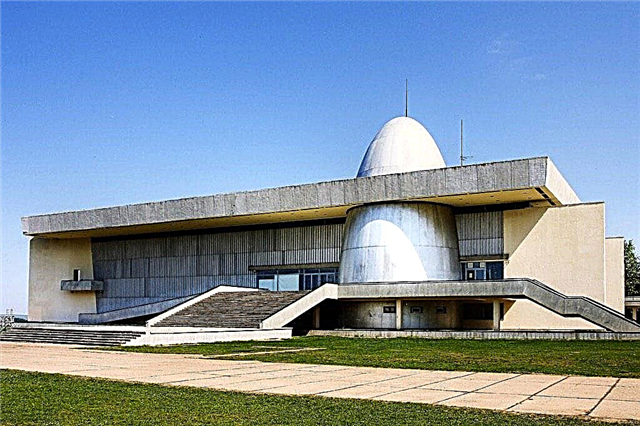Tourists who travel to the cities of the Golden Ring of Russia try to visit an unusual museum. Today the museum complex in Kaluga is the largest space museum in our country. It was created thanks to the efforts of Yuri Alekseevich Gagarin and Sergei Pavlovich Korolev. Here are collected rare exhibits that tell about the history of the development of astronautics on Earth.
Museum history
The foundation stone of the building was laid in June 1961. It is noteworthy that the first cosmonaut of the planet Yu. A. Gagarin took part in the solemn event. The construction of the new museum took several years, and in 1967 it received its first visitors.

The building of the Museum of the History of Cosmonautics named after K. Tsiolkovsky
The unusual complex of buildings was designed by a group of architects led by Boris Grigorievich Barkhin, and the best artists and sculptors of the USSR worked on the design of the museum. In the spacious lobby, you can see a large mosaic made of natural stone and smalt, which was made by the talented monumentalist Andrei Vladimirovich Vasnetsov.
For several decades, the Kaluga Museum has been coordinating the work of all space museums in Russia. A lot of scientific work is being carried out here, therefore, since the late 1970s, the museum complex has had the status of a research institution.

Hall of rocket and space technology
What can be seen in the museum
According to tourists, the Kaluga Museum is interesting for both adults and children. The museum funds store over 75 thousand exhibits. The most valuable are genuine relics and instruments, suits, space suits and personal belongings of astronauts. On a separate showcase there is a certificate number 1, issued to the first cosmonaut of the country.
The museum exhibits descent vehicles, a probe for studying the atmosphere, moon rovers and mock-ups of the first jet aircraft. Visitors are impressed by the soil from the moon, ejection seats, a treadmill for training astronauts and samples of space food. Many people linger for a long time near the stand, which is dedicated to animals that have been in orbit.

In the center: the descent vehicle of the Soyuz-34 spacecraft
The halls display a copy of the first satellite, several rocket engines, models of airships, balloons and airplanes. For tourists, a full-size model of the Mir station is open, which served space researchers from different countries from 1986 to 2001.
Rocket "Vostok"
The museum building is surrounded by a green park named after K. Tsiolkovsky, where there is a monument to the scientist. Not far from the entrance rises an unusual monument - the Vostok launch vehicle. It is curious that this is not a dummy, but an original rocket and space complex. During the launch of Yuri Gagarin into space, he was in reserve.

Launch vehicle "Vostok"
In April 1961, the famous Vostok-1, for the first time in history, lifted a man into Earth's orbit. He flew around the planet and landed in the Saratov region. The backup ship had exactly the same characteristics as the Vostok-1, so it was decided to keep it for history.
The rocket monument rises high above the ground. It is perfectly visible from the nearest districts of the city and from the opposite bank of the Yachensky reservoir.
Planetarium

Center: Vostok spacecraft
In 1967, simultaneously with the museum, the Kaluga planetarium was opened. It has a hall for 100 seats and a device of the German company "Carl Zeiss", with which you can project an image of the starry sky.
The planetarium contains several globes and a fragment of a meteorite from Sikhote-Alin weighing more than 40 kg. Four to five times a day, lectures with a demonstration of the stars are held here for everyone.
Useful information for visitors

Artificial communication satellite "Molniya-1"
The museum is open to tourists on Tuesdays, Thursdays and Fridays from 10:00 to 18:00, on Wednesdays from 11:00 to 21:00, and on Saturdays and Sundays from 10:00 to 19:00. Monday is a day off.
Children under 16 are admitted to the museum free of charge. A ticket for students and pensioners costs 150 rubles, and for adult visitors - 250 rubles. Exhibitions are paid separately. They don't take money for shooting amateur photos and videos.

Self-propelled vehicle "Lunokhod-2"
There is a shop at the museum where you can buy books on the history of astronautics, collections of memoirs, biographies of famous cosmonauts and design engineers. The store sells beautiful souvenirs and space-powered tubes.
Currently, the construction of new buildings of the museum is nearing completion. They will expand the existing area fivefold, and the museum will receive even more guests.

Layout of the station "Mir"
Excursions
Museum expositions can be viewed independently. However, many tourists prefer to walk through the halls together with experienced guides. Sightseeing and thematic excursions are held every day. They are organized individually and for groups of more than 7 people.
A guided tour of the museum takes about an hour. During the excursion, tourists are told about the first hot air balloon flights, the history of rocketry, the most famous cosmonauts and the milestones in the life of K. Tsiolkovsky.

Automatic station "Luna-16"
How to get there
The museum is located on Akademika Koroleva Street, 2. The building stands on the bank of the Yachensky reservoir, 5 km from the Kaluga-1 railway station. Near K. Tsiolkovsky Park, a 5-minute walk from the museum, bus number 3, trolleybuses number 1, 2 and 3 and route taxis number 1, 2, 71, 77 and 92 stop.
Attraction rating:











